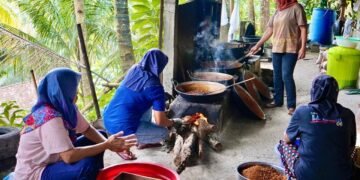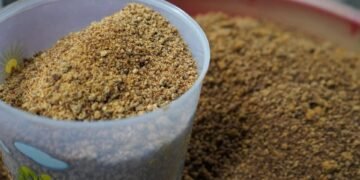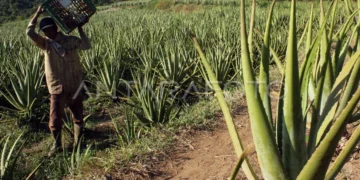Indonesians use a lot of cooking oil. In 2023, the National Food Agency recorded an average consumption of 9.56 kg/capita/year, which is equivalent to a total household demand of around 2.66 million tons/year (Ahdiat 2024).
This awesome figure generates a huge amount of waste: used cooking oil. Using used cooking oil as a biodiesel feedstock is a great solution because it can reduce fossil fuel imports while processing food waste.
Biodiesel is a biofuel that can replace diesel. It’s made by combining triglycerides from vegetable oils or animal fats through a chemical reaction called transesterification (Degfie et al. 2019). The end result is a mixture of fatty acid methyl esters (FAME) that is similar in properties to diesel.
Used cooking oil (WCO) is popular because it’s renewable and can help reduce emissions. A study in the journal Energies (2021) even says that “WCO biodiesel is one of the best local alternative fuels” for reducing diesel engine emissions (Yaqoob et al. 2021).
Chemical analysis is key.
Making biodiesel from used cooking oil isn’t as easy as just filtering out the impurities. Chemical analysis is key to this process.
Before processing, we test used cooking oil to make sure it’s up to standard. This waste oil is often contaminated with food particles, contains water, and most importantly, is high in free fatty acids (FFA) (Kristiana et al. 2023).
For example, Kristiana et al. (2023) found that used cooking oil in Indonesia had a water content of less than 1% and FFA levels between 1-2%. These high FFA levels mean you’ll need to add an extra step, like esterification, before processing.
After we make biodiesel, we test the samples again with some pretty advanced analytical techniques. GC-MS and FTIR spectroscopy are often used to figure out the FAME composition. For example, Farouk et al. (2024) reported biodiesel from used cooking oil with a FAME content of ~95.3% and a conversion yield of 92%. The biodiesel was later confirmed to meet quality standards (ASTM D6571) (Farouk et al. 2024).
There are a bunch of perks: Environment and Economy
When you swap diesel for biodiesel made from used cooking oil, you’re not only recycling toxic waste cooking oil, but you’re also cutting down on emissions of air pollutants (Degfie et al. 2019).
Yaqoob and his team’s study in 2021 found that WCO biodiesel can cut hydrocarbon (HC), SO2, CO, and soot emissions by about 85% compared to mineral diesel. It’s considered to be technically, economically, and environmentally feasible (Yaqoob et al. 2021).
In Indonesia, a life cycle study found that using used cooking oil for biodiesel can cut greenhouse gas (GHG) emissions by ~77% compared to diesel (Kristiana et al. 2023).
It has a lot of potential, but it’s not being used to its fullest.
There are a few case studies that show the real potential for using used cooking oil biodiesel in Indonesia. For example, PT GenOil in Makassar collects used cooking oil from hotels and food vendors and processes it into biodiesel for fishermen. This biodiesel is sold for around IDR 5,000/liter, which is cheaper than the price of Pertamina diesel (Osipova et al. 2023).
It’s funny, but even though there’s a lot of potential, it’s not really being used much. ICCT (2022) estimates that Indonesia could collect up to ~715 thousand tons of used cooking oil per year, which is equivalent to a potential production of ~651 thousand tons of biodiesel.
The truth is, we’re only producing around 0.7 thousand tons a year at the moment. Most of the used cooking oil is exported abroad (Kristiana et al. 2023). With the right policies and investments, like the current B30 program incentives, there’s a lot of potential for used cooking oil waste.
Sources:
Ahdiat A. 2024 Apr 22. Konsumsi Minyak Goreng per Kapita Indonesia Naik pada 2023. Katada Media Network. databoks. [diakses 2025 Sep 20]. https://databoks.katadata.co.id/agroindustri/statistik/8bcbef964f3570c/konsumsi-minyak-goreng-per-kapita-indonesia-naik-pada-2023
ADDIN Mendeley Bibliography CSL_BIBLIOGRAPHY Degfie TA, Mamo TT, Mekonnen YS. 2019. Optimized Biodiesel Production from Waste Cooking Oil (WCO) using Calcium Oxide (CaO) Nano-catalyst. Sci. Rep. 9(1):18982.doi:10.1038/s41598-019-55403-4.
Farouk SM, Tayeb AM, Osman RM, Abdel-Hamid SMS. 2024. Sustainable production of biodiesel from waste cooking oil using magnesium oxide nano catalyst: An optimization study. Sci. Rep. 14(1):22010.doi:10.1038/s41598-024-71930-1.
Kristiana T, O’Connell A, Baldino C. 2023. Produksi Biodiesel Berkualitas Tinggi dari Minyak Jelantah di Indonesia. Int. Counc. Clean Transp.
Osipova L, Carvalho F, Sturrup E. 2023. Used cooking oil’s potential to reduce GHG emissions from Indonesia’s fishing fleet.
Yaqoob H, Teoh YH, Sher F, Farooq MU, Jamil MA, Kausar Z, Sabah NU, Shah MF, Rehman HZU, Rehman AU. 2021. Potential of Waste Cooking Oil Biodiesel as Renewable Fuel in Combustion Engines: A Review. Energies. 14(9):2565.doi:10.3390/en14092565.
Syarat dan Ketentuan Penulisan di Siaran-Berita.com :
Setiap penulis setuju untuk bertanggung jawab atas berita, artikel, opini atau tulisan apa pun yang mereka publikasikan di siaran-berita.com dan klaim apa pun yang timbul dari publikasi tersebut, termasuk, namun tidak terbatas pada, klaim pencemaran nama baik, pelanggaran privasi, pelanggaran hak cipta, merek dagang, nama dagang atau pelanggaran paten, berita palsu, atau klaim lain apa pun yang didasarkan pada perbuatan melawan hukum atau kontrak, atau berdasarkan undang-undang negara Republik Indonesia
Selain itu, setiap penulis setuju, untuk membebaskan siaran-berita.com dari semua klaim (baik yang sah maupun tidak sah), tuntutan hukum, putusan, kewajiban, ganti rugi, kerugian, biaya, dan pengeluaran apa pun (termasuk penilaian biaya pengacara yang wajar) yang timbul dari atau disebabkan oleh publikasi berita apa pun yang dipublikasikan oleh penulis.”













































































